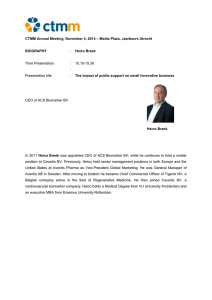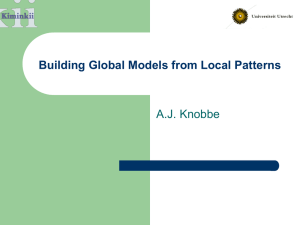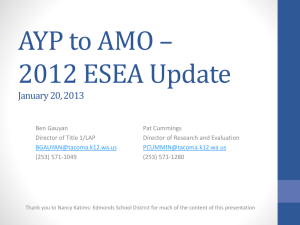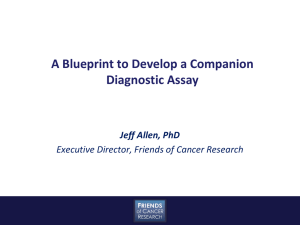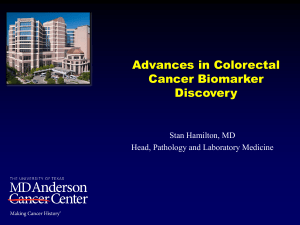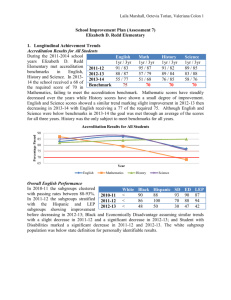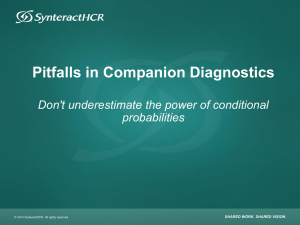Breakout Session 4: Personalized Medicine and Subgroup Selection
advertisement
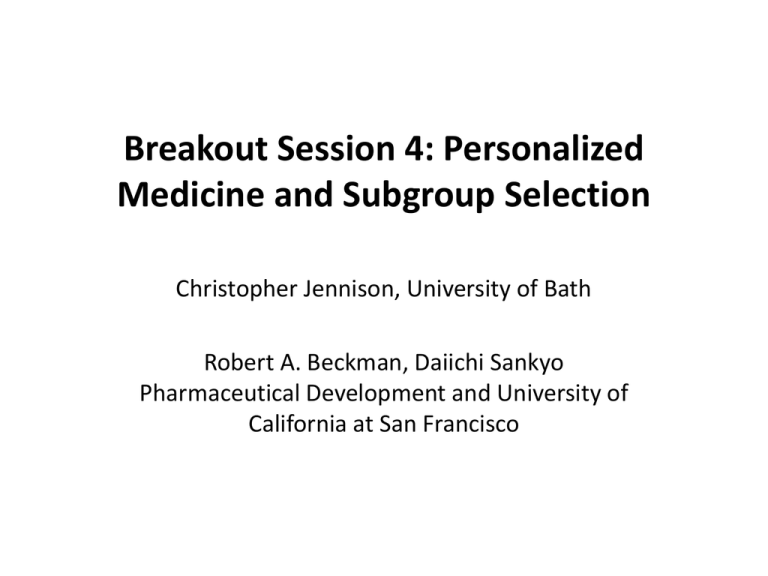
Breakout Session 4: Personalized Medicine and Subgroup Selection Christopher Jennison, University of Bath Robert A. Beckman, Daiichi Sankyo Pharmaceutical Development and University of California at San Francisco Agenda • TOPIC 1: Where do subgroups come from? Empirical data or basic science? How does this vary as a function of developmental stage? • TOPIC 2: Purpose of subgroups? Clinical ‒ to treat patients better? Commercial ‒ defining a niche market? How to handle continuous biomarkers ‒ what are tradeoffs involved in setting the cutoff? • TOPIC 3: How to design studies with subgroups in them? Topic 1: Where do Subgroups come from? Chris Jennison’s thoughts • The science behind the treatment’s mode of action and how it disrupts the disease pathway may imply that certain patients are more likely to benefit from the treatment. • If the treatment targets a particular protein, say, patients with high levels of this protein are likely to have the greatest benefit. • However, other patients may still benefit, but to a lesser degree. Topic 1: Where do Subgroups come from? Bob Beckman’s thoughts • Phase 2 subgroups would come from preclinical, Phase 0, and Phase 1 data • This early experimental data needs to be validated clinically • Recommend formal testing of a single lead predictive biomarker hypothesis defining subgroups. Single lead biomarker hypothesis avoids multiple comparisons • Other biomarker hypotheses/subgroups can be exploratory endpoints. If positive result in Phase 2, an exploratory subgroup would have to be prospectively confirmed in a new Phase 2 study • Phase 3 subgroups should be derived from Phase 2 clinical evidence • Phase 3 subgroup discovery generally does not allow enough time for companion diagnostic co-development Topic 2: Purpose of subgroups • Clinical: tailor therapy to patients who will benefit most – Increase benefit risk ratio for patients – Increase probability of success for drug developers – Possible cost reduction in phase 3 due to larger effect sizes • Commercial: greater benefit may allow acceptance by payors in increasingly demanding environment – May have smaller market, but larger effect size could lead to higher price and longer treatment times Continuous Biomarkers: the tradeoff involved in setting a cutoff • From Fridlyand et al, Nature Reviews Drug Discovery, 12: 74355 (2013). Topic 3: Recommendations for Trials with Subgroups Chris Jennison Within a Phase III clinical trial • Define biomarker positive (BM+) and biomarker negative (BM-) subgroups • Set up null hypotheses H0,1: no effect in the BM+ group H0,2: no effect in the full population • Start the trial with recruitment of patients from the full population (BM+ and BM-) • At an interim analysis, decide whether to continue with the full population or recruit only BM+ patients in the remainder of the trial (“enrich” the BM+ group) A Phase III trial with enrichment At the end of the trial • If recruitment continued in the full population, test H0,1 and H0,2 • If enrichment occurred, test H0,1 only • Use a closed testing procedure to protect familywise error rate for 2 null hypotheses • Use combination tests to combine data across stages Power of an adaptive trial design: an illustrative example We can assess the benefits of an adaptive enrichment design by comparing operating characteristics with a non-adaptive design. In the table below, θ1 denotes the treatment effect (treatment vs control) in the BM+ group and θ2 the treatment effect averaged over the full population. Non-adaptive design Adaptive trial design θ1 θ2 P(RejectH0,2) P(RejectH0,1) P(RejectH0,2) Total 1 20 20 0.90 0.04 0.83 0.87 2 30 15 0.68 0.47 0.41 0.88 3 20 10 0.37 0.33 0.25 0.58 4 20 15 0.68 0.15 0.57 0.72 Scenario 1: Treatment effect is the same for BM+ and BM- patients. Scenarios 2 and 3: Treatment effect is zero in the BM- group, all of θ2 comes from the BM+ group. Topic 3: Recommendations for Trials with Subgroups Bob Beckman • Power Phase 2 subgroups in efficiency optimized fashion • Randomized stratified Phase 2 study based on single prioritized biomarker hypothesis • 2D decision rule based on BM+ and BMsubgroups • If inconclusive, proceed to adaptive Phase 3 study (see below) Beckman, Clark, and Chen, Nature Reviews Drug Discovery, 10: 735-48 (2011). Example of adaptive study design (I) The Biomarker enriched P2 study • Biomarker (BM) enriched P2 study: – Designed to optimally test BM hypothesis by enrolling 50% BM+. – Trial powered for independent analysis of BM+ and BM- subsets. – Study has 4 groups: BM+ experimental, BM+ control, BM- experimental, BM- control – Size using Chen-Beckman method applied to BM+ and BM- subsets • 2D decision rule (Clark): see next slide June 17, 2014 11 2D Decision rule for MK-0646 triple negative breast cancer (Clark) June 17, 2014 12 Example of adaptive study design (II) The Biomarker adapted P3 study • BM Adaptive P3* – Study proceeds in full population. – Use data from P3 up to interim analysis and maturing data from P2 to: • Optimally focus analysis (“allocate alpha”) between full and sub-population • Maximize utility per cost function, such as power per study size, or expected ROI – Greater ROI than either traditional or biomarker driven P3 *Chen and Beckman, Statistics in Biopharmaceutical Research, 1: 431-40. (2009). June 17, 2014 13
